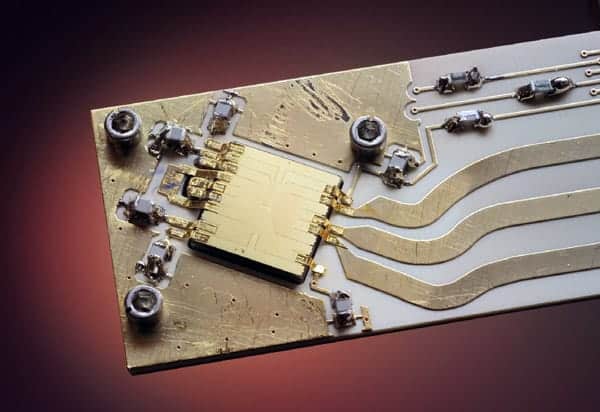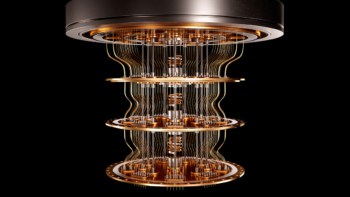
Two independent groups of physicists have made important breakthroughs in the control of quantum computers based on trapped ions. Instead of controlling quantum bits (qubits) using multiple laser beams, the teams have used microwave sources, which are much easier to control and integrate within quantum circuits. The work could lead to practical quantum computers that incorporate large numbers of qubits on a single chip.
The most successful quantum-computing system so far has been the ion trap – in which information is encoded in the electron spin states of ions that are confined by electric fields. In such systems, the electron spins of multiple ions can be put into a single quantum state in which they are no longer independent of one another. In this “entangled” state, which has no analogue in classical physics, correlations between ions can be used to perform certain logical operations that would take an unfeasibly long time for a classical computer.
Entangling multiple spins
However, entangling two trapped ions had required a pair of carefully aligned ultraviolet laser beams – which cannot be produced easily on an integrated circuit. To entangle two pairs of ions, two pairs of laser beams were needed and so on. A practical quantum computer would need a processor containing thousands or even millions of qubits, so scientists have long sought a way to manipulate many trapped ions without large numbers of laser beams.
In 2001 Christof Wunderlich and a colleague of the University of Hamburg had the idea of replacing the lasers with microwave and radio sources, which can be produced and controlled much more easily. Such radiation had previously been used in other trapped-ion experiments, but using it to implement quantum logic operations was a highly revolutionary suggestion. This is because the type of interaction required for quantum logic is usually very weak for this radiation. However, the researchers suggested adding a magnetic field gradient to stimulate the interaction.
Magnetic muddle
Unfortunately, the need to use states that are sensitive to static magnetic fields makes the quantum states vulnerable to the magnetic noise found all around us, and the technique proved problematic. In 2008 physicists at the Ion Storage Group at the National Institute for Standards and Technology (NIST) in Boulder, Colorado, proposed eliminating the static magnetic-field gradient and using instead the oscillating field produced by the microwave source itself. The benefit being that the quantum states used in this scheme are less vulnerable to magnetic noise and more robust.
Both research groups now report significant advances in the journal Nature. Wunderlich’s group, now at the University of Siegen, together with colleagues from the Institute of Theoretical Physics in Ulm, have come up with a way to produce states that, while still sensitive to the applied magnetic-field gradient, are far less vulnerable to noise and thus can be preserved more than 100 times longer. In a commentary accompanying the papers, Winfried Hensinger of the University of Sussex compares the group’s scheme to a car’s suspension system, which decouples the body from the wheels so that bumps in the road do not disturb the driver.
The NIST group, meanwhile, goes further and performs all of the essential quantum logical operations (albeit on only two qubits) using microwave radiation delivered via a waveguide integrated into a chip. “We’ve integrated the mechanism that does the entanglement between the two ions into the trapping structure,” says Christian Ospelkaus, who built the experiment together with colleagues at NIST. “We no longer need to build a really complex and sophisticated laser system around the whole camp: we just send an electric current through the trap structure and that generates oscillating fields and it does all the other coherent quantum operations we need to do.”
‘Strong case’ for investment
Hensinger says that the two papers together constitute a significant advance for the field of ion-trap quantum computing. “The papers make a very strong case for a heavy investment in terms of time, people and money to push this technology forward. If you’re a bank asking yourself where you want to invest your money, these two papers are strong evidence that trapped ions have quite a significant capability.”
The work is described in Nature 476 181 and Nature 476 185.



